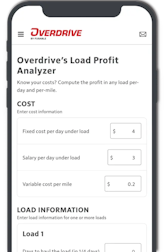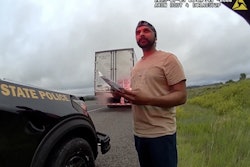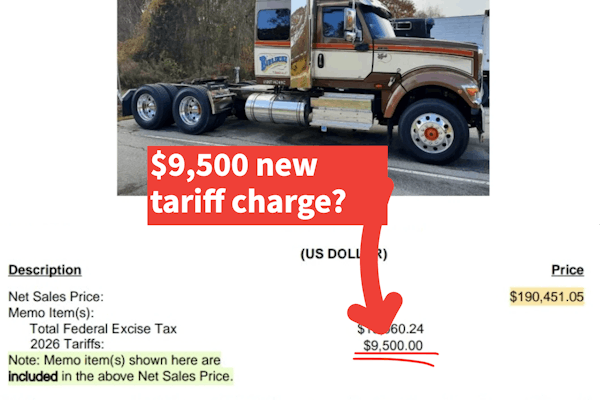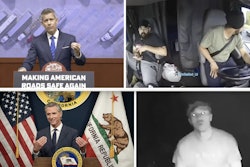The DOT recently called out three states for lack of follow-through on President Donald Trump's April executive order mandating English language proficiency for all commercial truck drivers in the U.S.
DOT told Overdrive that states have issued 3,100 out-of-service orders for truck drivers who failed the ELP assessment, but it's unclear if those drivers are actually staying off the road.
Specifically, DOT in August pointed to California, Washington and New Mexico as not enforcing ELP as an out-of-service violation and letting drivers who had been previously placed OOS for not speaking English simply drive off after inspections.
New Mexico State Police, called out by DOT for letting seven drivers placed OOS for ELP violations go, responded directly, saying there "is no easily accessible way for us to know if a driver has been placed out of service for a previous violation," according to New Mexico State Police Chief Troy Weisler.
Weisler said officers can only access inspections information at roadside by "manually reviewing numerous documents." That's even as DOT Secretary Sean Duffy himself called a past OOS violation a "flashing light" that inspectors should follow up on. FMCSA's chief counsel likened an ELP violation to a brake violation, saying no inspector would let a driver go without following up to find out if the brake problem was corrected.

To get a clearer picture of exactly what documents inspectors review during a stop and what they might be missing, Overdrive queried the Commercial Vehicle Safety Alliance, which is tasked with maintaining consistent inspections and the out-of-service criteria across three countries.
Ultimately, it looks like FMCSA and DOT may have conflated federal OOS Orders with driver-level OOS violations issued by states.
"The checking of OOS Orders and previously issued OOS violations/conditions on a prior inspection report are two different things," said Adrienne Gildea, CVSA's deputy executive director. "Federal OOS Orders are issued by FMCSA and are intended to halt all interstate operations of the motor carrier. Out-of-service violations, on the other hand, are issued to the individual driver or vehicle during a roadside inspection."
It is true, she added, that "an inspector’s inspection system will notify an inspector when they have queried a commercial motor vehicle or driver affiliated with a motor carrier who has been ordered to stop all interstate operations through an OOS Order."
Yet that same notification doesn't come through for individual OOS violations for the truck and/or driver, Gildea said. "The same functionality does not exist to notify inspectors of previously documented OOS violations/conditions. That information would only be accessible if the inspector did a manual review of the driver or vehicle’s entire inspection history, which is not practical roadside."
As far as FMCSA Chief Counsel Jesse Elison likening ELP violations to a brake-related violation, that doesn't totally hold up.
"It is true that previous inspection history can inform selection decisions," Gildea said, adding that, "however, inspectors do not necessarily consult previous inspection reports when inspecting a driver/vehicle. They are evaluating the state of the driver/vehicle at the time of inspection."
As a general rule, Gildea noted "inspectors do not base what they evaluate during an inspection on previous inspection history. Instead, the North American Standard Inspection Program sets the procedures inspectors follow when conducting a CMV inspection. If the inspection procedure requires that the brakes, for example, be inspected, then they will be inspected."
What exactly is the state police inspector looking at when they're in the squad car looking at the laptop? Couldn't an inspector, if they wished, find the driver's OOS records?
"Inspectors access a number of systems to conduct their inspections," she said. "An inspector has access to a driver’s license status and information through CDLIS or NLETS," references to national CDL credentialing (CDLIS) and criminal law enforcement (NLETS) databases officers can use to access an individual's history.
Using a motor carrier's DOT number or the truck/trailer's license plate, then, "an inspector is able to access the vehicle’s registration information, as well as the motor carrier’s [Safety Measurement System] profile information, including their safety rating," Gildea said. "This query will also allow them to access previous inspection history for the motor carrier or the driver."
But that query "simply pulls up the list of previous inspections," she said. "The inspector would have to manually review them to see what individual violations were cited."
So inspectors can see if a driver was placed OOS before, but it's not something they typically do, and something that requires a little more work on their part.
"Driver and vehicle OOS violations can only be viewed by an inspector if they search for and review each of the driver’s previous inspection reports individually through FMCSA’s database," said Gildea.
Before ELP enforcement came into play, experts predicted that spot market rates might jump by as much as 15% as non-English speaking drivers exited the industry. But now, more than two months into the new FMCSA guidance on ELP enforcement, rates have remained more or less flat, moving generally in line with seasonal expectations.
Finally, CVSA seemed to take New Mexico's side in the disagreement between the state and DOT over whether NMSP should have done an ELP assessment on driver Harjinder Singh, the trucker responsible for the triple-fatal crash in Florida that sparked the federal-state disputes to begin with.
New Mexico released bodycam footage of Singh's inspection (conducted five weeks before the tragic crash), and DOT said the state's inspector should have hit Singh with an ELP assessment after Singh said something unintelligible near the conclusion of the roadside stop. But FMCSA's own guidance and CVSA appear to say it's the inspectors call based on how the driver communicates during the stop.
"The guidance issued directs inspectors to conduct an English language proficiency evaluation if the inspector is given reason to believe the driver may not meet the standard set forth in § 391.11(b)(2)," said Gildea. "Application of the ELP evaluation is based on the inspector’s assessment of the driver’s compliance at the time of inspection."









